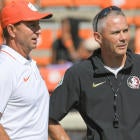When the subject of the College Football Playoff came up recently, Barry Alvarez was asked one of the sport's most significant questions this time of year: What if the SEC gets two teams in -- again?
"That would expedite ...," Wisconsin's athletic director said with a concerned sideways glance.
"... expansion of the four-team bracket?" he was asked as clarification.
"Yes," Alvarez confirmed.
Give the former member of the CFP Selection Committee credit for cutting to the core of what is now glaring back at us from the first set of those CFP Rankings released Tuesday: The possibility of the SEC getting two teams into the BCS/CFP for the third time since 2011.
LSU debuted at No. 2 in Tuesday's first CFP Rankings. Alabama is No. 3. They will play each other this week, possibly with neither being eliminated from the playoff chase.
Because of their resumes, cache, schedule strength and talent, both programs could end up among those final four teams a month from now on Selection Sunday.
"I can see that," LSU coach Ed Orgeron said. "... I believe they'd both deserve a shot."
It doesn't end there. Actually, the best scenario for the SEC to get two is for No. 6 Georgia to win out (finishing 12-1) and beat an undefeated LSU in the SEC Championship Game, according to CBS Sports bowls expert Jerry Palm.
Is there a conference that has better access to the CFP as we near the halfway point of the 12-year contract? No. Also, we should be used to it.
"If you don't like it, go beat 'em," Palm said. "You can't be mad at them because they're good."
That the SEC has multiple possibilities to get two teams into the field for the second time in three years is the point. Some of the same contentious reactions from previous years would emerge: The playoff should include conference champions only. We are tired of Alabama and the SEC. Etc.
In short, can the system stand another year of the SEC occupying half the bracket?
"There is going to be something every year," Palm added. "There are only four spots. You've got five major conferences. ... They designed this system to piss people off."
Makes for great controversy and conversation, not so much resolution in the first week of November.
Alvarez has been a significant voice for expansion having been inside the room on the committee from 2014-16. Michigan coach Jim Harbaugh has been advocating the same from the sideline. Neither of them have a say.
CFP executive director Bill Hancock has been steadfast in maintaining that the four-team model will hold firm through the end of the contract in 2025. Only the CFP Board of Managers (school presidents) can make a change. Nothing is imminent.
"[The playoff is] designed to fail to satisfy," Palm said. "Somebody is whining every year. It doesn't matter who it is, OK? They're going to whine for six more years because that's what they've got with this."
Take that, Barry.
None of that stops the SEC speculation/reaction/jealousy this time of year. Alabama is the only team to appear in all five CFPs. The Crimson Tide have made -- and won -- national championships twice recently without so much as winning their division (2011, 2017).
In order, the SEC's best chances for getting two in …
- Georgia wins out, beatin LSU for the SEC title. That would leave both at 12-1. Georgia would have wins over at least two top-10 teams (Notre Dame, Florida). LSU would have four such wins (Texas, Florida, Auburn, Alabama).
- Alabama wins out, beating Georgia for the SEC title. That would leave Alabama at 13-0, bound for the playoff. At 11-1, LSU would be in second place in the SEC West. That was Alabama's situation in 2017. The Tide went on to win the national championship.
- LSU wins out, beating Georgia for the SEC title. That is the shakiest SEC scenario. With its second loss, Georgia would be out. Alabama, at 11-1 and with questionable schedule strength, might need help.
"People ask me how we're doing right now. I say we're week to week," SEC commissioner Greg Sankey said. "We'll see week to week how this season plays out. I'm a patient person."
The Big Ten isn't out of the two-team conversation. Ohio State debuted at No. 1. The committee rewarded the Buckeyes for being the most complete team, despite not having the schedule strength of others.
That ranking suggests Ohio State could "afford" a Nov. 23 loss to No. 4 Penn State, which was afforded that opening slot over undefeated defending national champion Clemson. That's probably the Big Ten's best road to getting two teams in the playoff.
Since the BCS debuted in 1998, college football's championship process has forced folks to take sides. LSU fans erupted when their BCS-champion Tigers shared a national championship with USC in 2003. The Trojans snagged the final No. 1 ranking in that year's AP Top 25. The next year, Auburn went 12-0, won the SEC and was left out of the BCS. That got things rolling toward a playoff. Never again would an undefeated SEC champion be excluded. The best way to ensure that was to go to a four-team playoff.
When it began to evolve, former SEC commissioner Mike Slive made sure to advocate for the four best teams, not just conference champions. Without saying it, Slive knew that, in such a structure, the SEC would be in the best position to get multiple teams in the bracket in any given year.
Sankey called 2011 "a crystallizing moment." The Alabama-LSU rematch was great for the SEC, but the nation voted with their eyeballs. TV ratings were down. The BCS had reached its breaking point. The next summer, the CFP was established.
Despite Clemson and Alabama combining to win the last four playoffs, ratings have held steady. The CFP has also gotten it mostly right in that there hasn't been the yearly controversies that seemed to plague the BCS.
The SEC hasn't squandered the opportunities, winning 10 of the last 16 national championships and nine of the last 13. Within that, it won seven titles in a row from 2006-12. Slive's vision resonates today. Only 11 of the combined 20 teams in the first set of rankings have made it to the playoff. Six of those 20 have been from the SEC (Alabama five times, Georgia once). The ACC is next with five appearances (all Clemson).
Florida coach Dan Mullen made the most concise -- though not new -- SEC argument recently speaking to the New York Times.
"If you look at a lot of these other teams, they don't have to go through a gauntlet, and it would be interesting to see if they did," Mullen said. "The top team in the Big 12, the top team in the Big Ten, the top team in the ACC are all as good as the best teams in the SEC. The problem is, last week, there were, what, five of our teams in the top 10? So if Clemson, Oklahoma, Ohio State, Notre Dame -- if they were all in the same conference, it would be interesting because that's kind of what it looks like in this league."





















